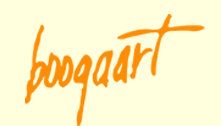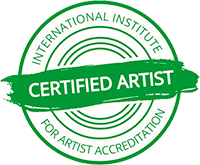
Realistic painter Dinie Boogaart
Publications
Painter Dinie Boogaart each time undergoes the creation of her oil paintings as an adventure.
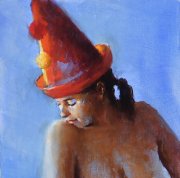

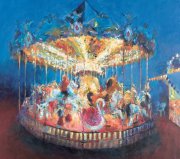
Dinie Boogaart, who was born in Sneek (Friesland), realised at an early age that she had a talent for the plastic arts, drawing and painting, and that she had to demonstrate her talents. At the age of seventeen she went to the Academie voor Beeldende Kunsten (Academy of Visual Arts) in Kampen, after which she moved to the Rijksacademie Amsterdam, where she successfully took her final exams, and next she went to Minerva, the Groningen-based Academy of Visual Arts, for her teaching qualifications.
These three academies were major influences on her development as a painter. In Kampen Dinie Boogaart learned how to empathise with the model during model drawing. ‘Literally and figuratively you have to feel how the human body is constructed. The forms should always be right. And in Amsterdam she moulded in clay. ‘This has taught me quite a lot.’ These were some prerequisites for later being able to develop a style of her own.
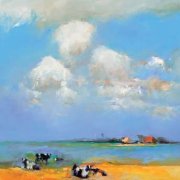
Painting she considers to be a craft, requiring a strict and daily discipline. In this she brooks no compromises, for in her view ‘you have to enforce inspiration.’ Though her studio is a model of tidiness and order (‘In this I am a very organised person’) she admits that inside her head she is ‘chaotic’. ‘Ideas and subjects are continually popping up in my mind. During the daytime but also at night in bed.’ Her work is as it were imprisoned in her mind. ‘But,’ she immediately adds, ‘I do not of course lose sight of daily reality. You regularly have to distance yourself and to see things in perspective.’
She is a doer and in her view the final result on the canvas is what is crucial. ‘Again and again this is a thrilling experience. But not everything is a success.’ With respect to this she refers to a saying by the Swiss-German author Hermann Hesse: ‘Talent has to coupled and balanced with character, inspiration with discipline, skill and the creative urge with restraints.’ This has become her motto.

Over the past several years she has exhibited her paintings in a lot of well-established Dutch galleries and she is still participating in group exhibitions a couple of times every year. ‘I want to show my face and hence my work in other parts of the country as well.’
Since the early nineties she has had a gallery of her own in Nijega, near Drachten, showing exclusively her own paintings. So quite a luxury. ‘No, I am not complaining.’ Every autumn, from late November till mid-December this gallery shows her most recent work with between 30 and 40 paintings.
Last year this took place for the ninth time. Interest was considerable with corresponding sales.Those interested came from the Netherlands, Belgium,Germany, France and Great Britain.That people like her work she appreciates, but that is not all. ‘Paramount to me is the pleasure I have in my work and the affinity I develop with my canvases. That is why I sometimes have a hard time letting them go.’
Writer: Tjakko Kars , director magazine " Kijk op 't Noorden " november 2008
Translation: Geart van der Meer
Gallery Dinie Boogaart
Kommisjewei 21-23
9217 RL Nijega The Netherlands
tel. 0031 512 372735
e. info@dinieboogaart.nl
i. www.dinieboogaart.nl
The gallery is usually open on Sundays from 13.00 to 17.00 and of course by appointment and, during the autumn exhibition of her latest works, on Friday, Saturday and Sunday from 13.00 to 18.00.
Her latest book was privately published in November 2007 entitled Zoeken (‘Searching’). It provides a overview of Dinie Boogaart’s paintings, portraits and landscapes from 2000 up to and including 2008. To be ordered by email info@dinieboogaart.nl
